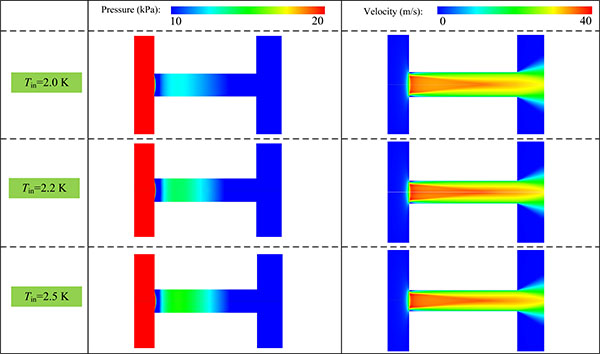The Joint Team from Boreas Cryogenics and SITP Achieves New Significant Progress in the Throttling Process of 3He in the mK Cryogen-free Dilution Refrigerator
Back
2024-03-18
The final stage of a dilution refrigerator primarily utilizes the significantly different properties of 4He and 3He at specific temperatures around 0.87 K to achieve mK cooling. 4He and 3He are two stable isotopes of helium found in nature. At extremely low temperatures, both become quantum fluids and exhibit remarkable superfluid phenomena at specific temperatures. 4He is a boson and obeys Bose-Einstein statistics, while 3He is a fermion and follows Fermi-Dirac statistics. This difference is reflected in their superfluidity transition temperatures. 4He undergoes Bose-Einstein condensation near 2.172 K, thereby transitioning into a superfluid state. 3He, which obeys Fermi-Dirac statistics, does not undergo Bose-Einstein condensation. Instead, it transforms into a superfluid state only at an extremely-low temperature of 2.6 mK through a special type of condensation. The conventional explanation for this phenomenon requires using the BCS theory in superconductivity research.
Although 4He is also a noble gas, it has relatively stable natural sources (such as natural gas). The technologies for its extraction, purification, and liquefaction were developed early and have now become relatively mature, reaching a certain industrial scale. Consequently, research on the properties of 4He is quite thorough, and its practical applications are extensive.
The situation with 3He is quite different. Unlike ordinary conventional gases and its isotope 4He, the specialty of 3He lies in its extremely scarce sources. The natural abundance of 3He is less than one millionth of that of 4He, so it is almost impossible to extract a practically useful amount of 3He from nature. Although the content of 3He on the moon is abundant, its mining and transportation schemes are still at the conceptual stage. Consequently, since its discovery in 1920, almost all 3He applied in scientific research and industries was obtained from nuclear reactors (mostly as a byproduct). Although there are certain commercial channels for the purchase of 3He, the price is extremely high due to the difficulty and scarcity of its source.
The scarcity of 3He sources led to relatively limited research on its properties. Certain peculiar properties of 3He often need to be manifested under extremely-low temperatures over several orders of magnitude (a fact only understood later), which further intensifies the research challenges. For instance, 4He was liquefied in 1908, while it took another 40 years for 3He to be liquefied. 3He was also the last gas to be liquefied in nature. The superfluidity of 4He was discovered in 1938. The discovery of the superfluidity of 3He was delayed until 1972.
In recent years, due to the rapid development of quantum technology, research of 3He has once again aroused great interest. The growing demand for mK cooling in critical quantum computing fields such as superconductivity and topological systems has transformed dilution refrigerators - once an a field that has rarely been studied before - into one of the forefronts and hotspots in cryogenics. 3He is one of the two key working medium in dilution refrigerators. However, the current research key point has shifted significantly from previous one: the main emphasis has transitioned from fundamental properties of 3He itself, such as its intrinsic thermal and transport properties, to specific studies of its working mechanisms within dilution refrigeration cycles including flow and heat transfer processes in dilution refrigeration systems. These are the previously neglected aspects of 3He research.
The lack of related research is closely due to the development history of dilution refrigerators. The dilution refrigeration cycle was proposed in the 1950s and a practical model was developed in the 1960s. Afterwards, for nearly half a century, its main applications were basically limited to low-temperature physical research in laboratories. These studies were relatively scattered, and the requirements for the dilution refrigerators were also relatively loose. For example, there were no strict requirements for some key parameters such as cooling capacity, efficiency, MTBF, weight, volume, energy consumption, etc. Especially because of the very small market scale and extremely limited suppliers, the situation of mutual dependence and compromise formed between the supply and demand sides over a long period of time also made the researchers lack the initiative for technological innovation.
However, after the second decade of the 21st century, especially in the past four or five years, with the explosive technological progress in the quantum computing, this situation has been rapidly changed. In order to keep up with the increasingly practical development pace of the quantum computing field, it is necessary to optimize or even completely innovate the previously solidified cycle process and even the designed model of dilution refrigerators. What takes precedence among these is the thermodynamic, heat transfer, and fluid mechanics characteristics and behaviors of the 3He working medium in the dilution refrigeration cycle, because as mentioned before, research in these aspects is far from sufficient.
However, after the second decade of the 21st century, especially in the past four or five years, with the explosive technological progress in the quantum computing, this situation has been rapidly changed. In order to keep up with the increasingly practical development pace of the quantum computing field, it is necessary to optimize or even completely innovate the previously solidified cycle process and even the designed model of dilution refrigerators. What takes precedence among these is the thermodynamic, heat transfer, and fluid mechanics characteristics and behaviors of the 3He working medium in the dilution refrigeration cycle, because as mentioned before, research in these aspects is far from sufficient.
The joint research team from Boreas Cryogenics and Shanghai Institute of Technical Physics (SITP) conducted a comprehensive and systematic study on the cryogen-free dilution refrigerator with full technology chain and high cooling capacity in recent years. Part of the researches is focused on clarifying the mechanisms and optimizing the processes of 3He as a working medium in the dilution refrigeration cycle. Important progress has already been made, and related work will be published successively to engage in academic exchanges with international peers. We introduce one of the latest achievements: a article titled "Investigations on the Throttling Process of 3He in a Dilution Refrigerator Used for Cooling Superconducting Quantum Chips" has been published in the international journal Cryogenics.

Fig. 1. Geometric model for simulation: (a) Dilution refrigeration cycle; (b) Structure of impedance component.

Fig. 2. The state of 3He: (a) State distribution on T-S diagram; (b) State distribution on P-T diagram.

Fig. 3. Schematic diagram of the improved Lee phase transition model.
In dilution refrigerators, the impedance throttling component is one of the key parts in the cycle process of the 3He working medium. Its main function is to control the flow of the 3He working medium and ultimately liquefy the 3He gas. This function is crucial for the dilution refrigerator to achieve mK temperature. We found that there was a certain deviation between the throttling process of 3He based on the isenthalpic expansion assumption and the real process. Moreover, as the critical temperature of the working medium decreases, the resulting deviation becomes increasingly obvious. Therefore, the method based on the isenthalpic expansion assumption was not suitable for studying the influencing factors of the impedance throttling performance in the two-phase range. Clearly, the isenthalpic expansion assumption could not be used to solve the throttling problems at extremely-low temperatures.

Fig. 4. The contours of temperature and VF near the impedance component.

Fig. 5. The contours of pressure and velocity inside and outside of the impedance for different inlet pressures.

Fig. 6. Refrigeration performance under different inlet pressure: (a) Mass flow rate; (b) Liquefaction ratio of 3He; (c) Isentropic expansion, isenthalpic expansion, and simulation result on T-S diagram.

Fig. 7. The contours of pressure and velocity near the impedance component under different inlet temperatures.
Thus, this paper proposes a new throttling model for the 3He working medium, which focuses on the complex physical characteristics of 3He and the impact of the transition from the supercooled state to the saturated state on the cooling performance during the throttling process. The paper explains the effect of the inlet pressure and inlet temperature on the flow rate of 3He and discusses the changes of energy conversion on the throttling process. The results show that the proposed throttling model can reasonably predict the flow rate of the 3He working medium with different inlet pressures and inlet temperatures, which has guiding significance for the design and optimization of cryogen-free mK dilution refrigerators.
Link to the article:
Back
